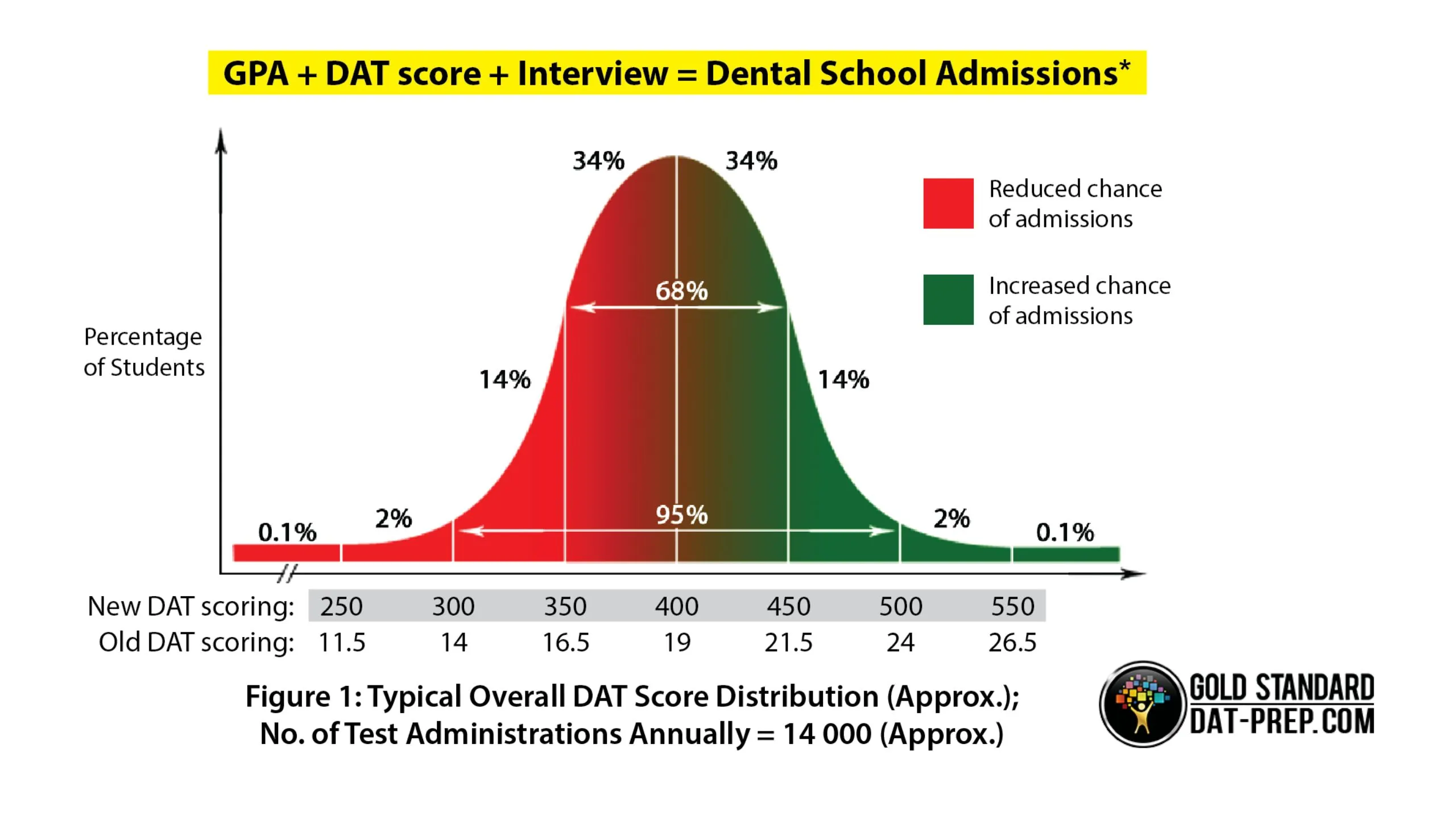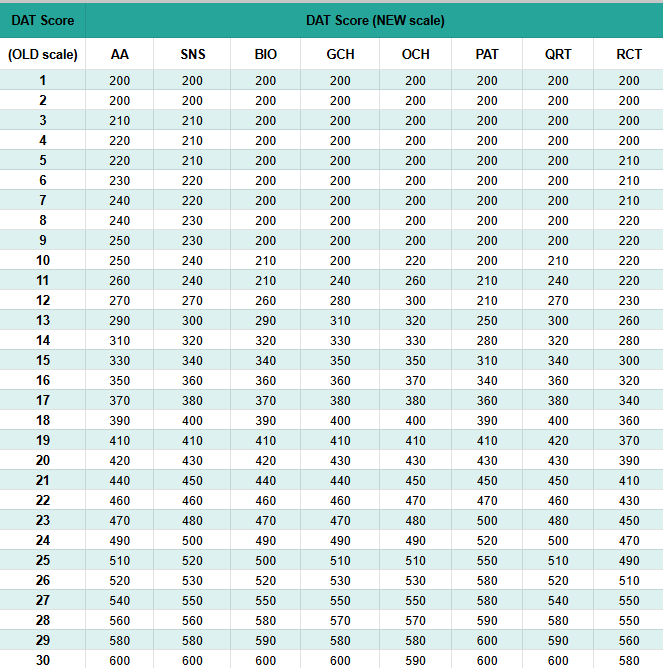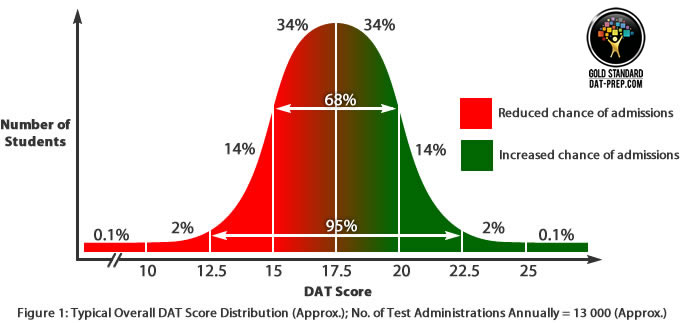- Email: learn@dat-prep.com
- Phone: 1-866-333-3138
Table 1: Average DAT scores (Academic Average, AA) and GPA scores of Students Admitted to US Dental Schools (enrollees; ref:ADEA Official Guide to Dental School, 2025-2026). The ADEA does not release DAT scores data every year so we expect the next update to be sometime in 2027. Below the real DAT scores out of 30 in the table, we have added the New Estimated Score (NES) based on the new DAT scoring system out of 600 (the new DAT scoring system came into effect March 1, 2025; details about the rationale and the conversion scales are at the bottom of this page). Note that there has been no change in the content of the exam itself. NES are Gold Standard DAT estimates.
Note that over the last few years, average DATscores and GPA requirements have been relatively stable within the dental school admissions process. Nonetheless, the requirements you may attain for admissions for the study of dentistry in 2026 or 2027, may be somewhat different from previously available data. Click on any of the links in the table for more details or to contact the admissions committee for any clarification regarding your candidature. Note that an average DAT score for admissions, is not the same as a cutoff (lowest possible) DAT score which may vary according to the dental program.

*Note: In general, dental school admissions committees will only examine the DAT score if the GPA is high enough; they will only admit or conduct a dental school interview if the combination of GPA + DAT score is high enough. Some programs also use autobiographical materials and/or references in the admissions process. Different dental schools may emphasize different aspects of your DAT score, for example: PAT, BIO, TS, AA. The average DAT score for any section is approximately 400/600 in the new scoring system (approximately 18-19/30 in the old system); the average AA for admissions is usually 400-440/600 (18-21/30) depending on the dental school; the AA for admissions to Harvard is around 470-500/600 (23-24/30); the F99th percentile is usually 530/600 (25/30) meaning that 99% of the approximately 13 000 students who take the DAT every year have an AA less than 530. Only a handful of students score 530. The two student contributors to the new Gold Standard Masters Series DAT books scored 540 (27/30, AA).
| Canada | Average DAT Scores (AA) | Average GPA |
|---|---|---|
| University of Alberta Faculty of Medicine & Dentistry School of Dentistry | NR | 3.85 |
| University of British Columbia Faculty of Dentistry | 22.3 | NR |
| University of Manitoba College of Dentistry | 20.6 | 4.06 |
| Dalhousie University Faculty of Dentistry | 21 | 3.7 |
| University of Toronto Faculty of Dentistry | 23 | NR |
| Western University Schulich School of Medicine & Dentistry | 21 | 3.9 |
| McGill University Faculty of Dentistry | NA | 3.82 |
| Université de Montréal Faculté de Médecine Dentaire | NR | NR |
| Université Laval Faculté de Médecine Dentaire | NR | NR |
| University of Saskatchewan College of Dentistry | 19.9 | 87.14 |
According to the ADA, the DAT scoring system changed to “yield more precise and accurate estimates of candidates’ skills”. Referring to psychometric data, it is the opinion of Gold Standard DAT that the changes were implemented to better suss out the differences in the majority of scores needed for admissions. For example, in the old system, just a difference of 3 out of 30 can have a massive impact on admissions. In the new system, that could represent as much as 60 out of 600, which, in an exam that includes scores based on multiple sections, will allow the reporting system to demonstrate fine differences between students better (especially in and around typical scores for dental school admissions). Note that there have been no content changes to the current exam.
Since March 1, 2025, the 2-digit score reporting scale (1 to 30) was replaced by a 3-digit reporting scale (200 to 600). All students taking the DAT now and in the future, will only have their scores reported using the 3-digit reporting scale. A conversion table linking the old DAT scores to the new scores can be found below:

Data from the table is available from: ADA DAT Reporting Scale
DAT scores are reported by the ADA (American Dental Association) as eight standard scores. The first six scores are from the individual tests themselves, i.e. biology, general chemistry, organic chemistry, perceptual ability, reading comprehension, and quantitative reasoning. These multiple choice questions are first scored right or wrong resulting in a raw score. Note that wrong answers are worth the same as unanswered questions so ALWAYS ANSWER ALL THE QUESTIONS even if you are not sure of certain answers. The raw score is then converted to a scaled score ranging from 200 (lowest) to 600 (highest). A test section that is skipped will be scored 200. This is neither a percentage nor a percentile.
The test is not based on a curve. Essentially, DAT performance is measured using an ability-referenced system. Based on standard scores, your abilities (i.e. knowledge and problem solving skills) are directly compared to that of the other DAT examinees.
The remaining two scores are Total Science (TS) and Academic Average (AA). The Total Science score is the standard score for the 100 questions in the Survey of Natural Sciences as a whole – NOT THE AVERAGE OF THE STANDARD SCORES of the Science subtests. This is derived from the sum of your raw scores each in biology, general chemistry, and organic chemistry. The total score is then converted to a standard score for Total Science. In contrast, a score in the Academic Average is the rounded average of the standard scores from the reading comprehension (RC), quantitative reasoning (QR), biology (BIO), general chemistry (CHM), and organic chemistry (ORG) tests. Here is an example of an Academic Average calculation:
| QR – 420 | RC – 410 | BIO – 460 | CHM – 440 | ORG – 430 |
TOTAL: 2160 ÷ 5 = 432; rounded to the nearest ten multiple, the Academic Average for these scores would be 430. Standards for interviews or admissions may vary for the individual scores, Total Science and the Academic Average. For example, one particular dental school may establish a cutoff (minimum) of 410 for all sections. In other cases, admissions committees assess candidates against a mean of DAT scores in a particular batch of applicants; therefore, the range can vary from year to year. Consider examining DAT scores from dental schools in the table by scrolling up on this Gold Standard DAT webpage.
There is no "pass" or "fail" grade for the DAT since the ADA uses an ability-referenced measurement. Your standard score indicates your test performance relative to all the students who completed the same test on the same day. This means that the national average on the scored sections is not always a guarantee for acceptance in a dental program. In most instances, what is considered "average" depends on the entering batch of a particular academic year. In other words, you are not trying to pass or fail but rather you are trying to achieve a score acceptable to the dental school that you wish to attend.
Please keep in mind that the percentile rank indicates your test performance relative to all the students who did the same test on the same day. It records the percentage of students whose scores were lower than yours. Percentile ranks are not used as dental school admissions criteria and the following percentile ranks fluctuate significantly from year to year.
| DAT Score (Quantitatively) | Percentile | DAT Score (Qualitatively) |
|---|---|---|
| 390-400/600 (old: 17-18/30) | 50th | Average |
| 430-440/600 (old: 19-20/30) | 75th | Usually Good |
| 500-530/600 (old: 22-23/30) | 98th | Very High |

As of the time of publishing this Gold Standard DAT webpage, the ADA no longer releases DAT scores on the same day. Unofficial score reports will not be available at the testing site because the new scoring system requires additional analyses to ensure accuracy.
Prior to March, 2025, right after completing the DAT, students were provided with an unofficial score report at the Prometric Test Center. That report would later be audited for accuracy and verified by the Department of Testing Services. Official scores were then forwarded within three to four weeks to the dental schools, which were indicated on your DAT application.
The ADA also releases your scores to the appropriate standardized application service such as the Associated American Dental Schools Application Service (AADSAS) or the Texas Medical and Dental Schools Application Service (TMDSAS) in case the specified dental schools participate in any one of these services. Scores are then posted to your dental school application and then forwarded to the respective faculties within one week. In such a case, you can confirm the proper submission of your official DAT scores by logging into your ADEA AADSAS application. Requests of additional copies and/or recipients mean additional fees and transmittal time. For more details about this process, please check the ADA website.
The average DAT (AA) score for students accepted to dental school in 2024 was 440/600 (old scale: 21/30). The DAT score range for these first-year enrollees (class entering Fall 2024) was 370-510/600 (old scale: 17-25/30). Note that the average DAT score for the entire pool of students taking the DAT is 400/600 (old scale 18-19/30).
The average GPA for the class of 2024 was 3.59 (range: 3.00-4.00). Of course, obtaining an average DAT score does not guarantee admissions. For more details, consider acquiring the ADEA’s:Official Guide to Dental Schools, 2025-2026 edition.
The Gold Standard DAT's best prep for a high DAT score includes 6 paperback books (also available as eBooks), online NS videos, MP3s/audio files, flashcards and full-length practice tests. Our team of authors includes applicants with very high DAT scores (AA: 27) who were accepted to Ivy League dental schools. Come learn from our experience. Click on the image below for more information.